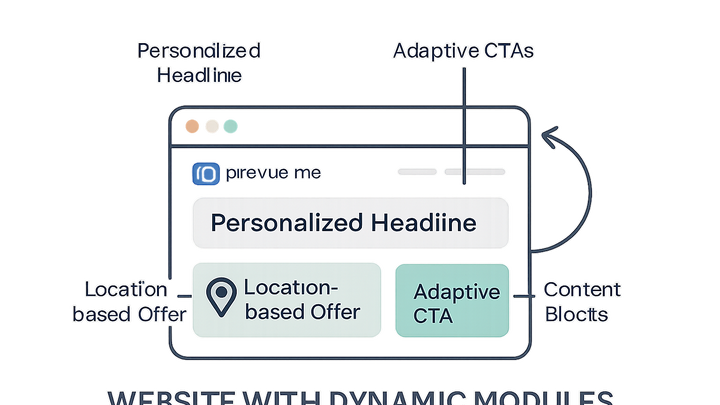Published on 2025-06-29T20:49:19Z
What is Dynamic Content? Examples and Best Practices
Dynamic Content refers to website elements that change in real-time based on user data, behavior, or preferences. By delivering personalized experiences—such as tailored headlines, product recommendations, or location-based offers—dynamic content increases engagement, satisfaction, and conversions. In the context of conversion rate optimization (CRO), dynamic content can significantly improve lead generation by presenting the most relevant calls-to-action and messaging to each visitor segment. From a UX standpoint, adaptive interfaces that respond to user context make the browsing journey smoother and more intuitive. Even SEO benefits when dynamic content is properly optimized for crawlability and relevance, as search engines reward websites that deliver value to users. Tools like Prevue.me provide actionable critiques for implementing dynamic content strategies that maximize lead generation, improve UX, and maintain accessibility compliance.
Dynamic content
Dynamic content adapts website elements based on user data to boost personalization, engagement, conversions, and SEO relevance.
Why Dynamic Content Matters in CRO, UX, and SEO
Dynamic Content allows websites to tailor experiences to individual users, making each visit more relevant and engaging. By presenting the right message at the right time, businesses can optimize conversion rates, reduce bounce rates, and foster customer loyalty.
From a CRO perspective, personalization powered by dynamic content ensures that calls-to-action resonate with visitor intent. For UX, adaptive interfaces create seamless journeys, and for SEO, contextually relevant content can improve key metrics that search engines value.
-
Personalization boosts engagement
By delivering content that matches a user’s interests and behavior, you capture attention and encourage deeper site exploration. Personalized experiences can increase click-through rates by up to 50%.
- Tailored messaging:
Headlines and copy change based on user data like past visits or referral source.
- Customized offers:
Special promotions or product suggestions are shown only to relevant audience segments.
- Tailored messaging:
-
Improved conversion rates
Dynamic Content surfaces the most compelling calls-to-action based on real-time user behavior, leading to higher form submissions and sales.
- Real-time recommendations:
Suggest products or content while users browse, increasing the chance of conversion.
- Real-time recommendations:
-
Enhanced seo relevance
When dynamic content is properly rendered server-side or indexed via dynamic rendering, it boosts relevance signals for search engines.
Common Types of Dynamic Content
Websites employ various types of dynamic content to adapt to user contexts. Choosing the right type depends on your goals and the quality of audience data.
-
User-based content
Content personalized to individual user profiles or behaviors.
- Location-based offers:
Display region-specific deals or store information.
- Behavior-triggered messages:
Show messages based on actions, such as exit-intent popups.
- Location-based offers:
-
Contextual content
Adapt content based on context like time, device, or referral source.
- Time-sensitive banners:
Promote limited-time offers during specific periods.
- Device-specific layouts:
Optimize layouts for mobile, desktop, or tablet experiences.
- Time-sensitive banners:
-
Predictive recommendations
Use algorithms to predict and suggest products or content.
- Product suggestions:
Recommend items based on browsing history or cart contents.
- Article recommendations:
Serve related blog posts to keep readers engaged.
- Product suggestions:
Implementation Strategies and Best Practices
Implementing dynamic content effectively requires a combination of data collection, testing, and technical considerations to ensure performance and accessibility.
-
Audience segmentation
Gather and segment user data to deliver personalized experiences at scale.
- Use web analytics:
Leverage tools like Google Analytics to identify key audience segments.
- Profile enrichment:
Integrate CRM data for deeper personalization.
- Use web analytics:
-
A/b testing and personalization tools
Continuously test variations of dynamic content to find the highest-performing versions.
- Multivariate testing:
Test multiple elements simultaneously to optimize complex pages.
- Machine learning models:
Employ AI-driven personalization engines for advanced targeting.
- Multivariate testing:
-
Seo and accessibility compliance
Ensure dynamic content does not hinder crawlability or accessibility.
- Server-side rendering:
Render dynamic portions on the server to make them indexable.
- Accessible content fallback:
Provide fallback content or ARIA attributes for assistive technologies.
- Server-side rendering:
Examples with Prevue.me
prevue.me offers actionable critiques and recommendations for dynamic content strategies, enhancing lead generation and user experience.
-
Dynamic ctas based on visitor source
prevue.me analyzes traffic sources and suggests tailored CTAs, such as highlighting case studies for organic visitors or trial prompts for paid ad clicks.
-
Personalized content blocks
prevue.me identifies key audience segments and recommends dynamic content blocks like industry-specific testimonials or product showcases to increase relevance.
